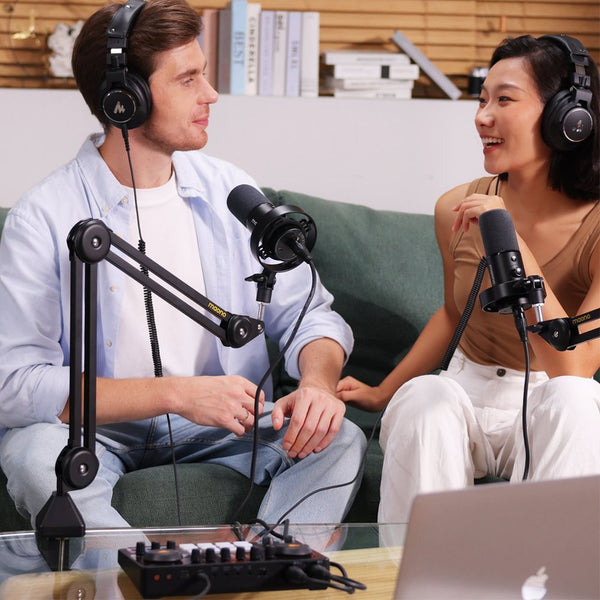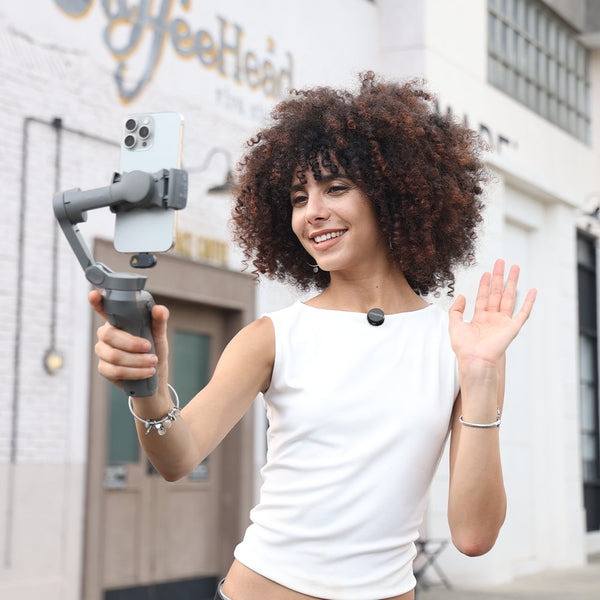Editing content is often an intimidating task, especially for beginner podcasters. But what do beginners commonly ask when starting a podcast? This article will address those questions, including recommendations for the best type of microphone for podcast success.
Podcasting has become one of the most popular ways to share stories, ideas, and information. But creating a successful podcast involves more than just hitting the record button. Editing and microphone quality are critical to delivering clear, engaging audio that keeps your listeners coming back. Whether you're just getting started or looking to polish your sound, this guide will help you understand how to edit a podcast and choose the right podcast microphone for professional results.
Why Do You Need to Edit Your Podcast?
Raw audio rarely sounds perfect. Even the best recordings usually contain background noise, awkward pauses, filler words like “um” or “uh,” and uneven volume levels. Editing helps you remove these distractions, enhance clarity, and improve pacing. It turns your initial recording into a polished, listener-friendly experience.
How Do I Edit My Podcast If I Have No Experience?
You don’t need to be a sound engineer to edit your podcast. Today’s user-friendly software tools make the process accessible even for beginners. With some practice and basic audio editing knowledge, you can cut unnecessary content, clean up background noise, and ensure your podcast flows smoothly.
What Is the Importance of a Reliable Podcast Microphone?
A reliable mic for podcasting is the foundation of good audio. Even the best editing software can't fix poor sound quality from a low-end or improperly placed mic. A high-quality podcast mic captures cleaner, richer audio upfront, reducing the time you'll need to spend editing and improving your podcast's overall professionalism.
What Software Is Best for Editing a Podcast on a Budget?
There are several powerful and affordable (or free) editing tools perfect for podcasters:
Descript
Great for beginners, Descript transcribes your audio and lets you edit it like a text document. It also includes tools for removing filler words and background noise with a few clicks.
Audacity
This free, open-source audio editor is popular for its advanced features and flexibility. It's ideal for those who want complete control over the editing process.
Adobe Audition
A professional-grade audio workstation with robust editing tools, great for advanced users who want precise control. While it’s not free, it’s worth the cost for serious podcasters.
GarageBand
Free for Mac users, GarageBand offers a simple interface and solid editing tools, perfect for beginners who want to record and edit in one place.
How Do I Remove Background Noise from My Recordings?
Most editing software includes noise reduction features. Here are some basic steps:
-
Record in a quiet environment and use a pop filter.
-
Use directional mic for podcast setups to focus on your voice.
-
In your software, highlight a few seconds of pure background noise.
-
Apply a noise reduction effect to eliminate consistent ambient sounds.
Tools like Descript and Audacity make this process beginner-friendly, often with presets designed for podcast cleanup.
What’s the Easiest Way to Cut Out Filler Words Like “Um” and “Uh”?
Descript’s AI feature automatically identifies filler words and lets you delete them in bulk. In other tools like Audacity or Adobe Audition, you’ll need to manually highlight and cut these parts from the waveform. Over time, you’ll get faster at spotting and removing them.
Should I Edit My Podcast Myself or Hire Someone?
If you have the time and enjoy learning new skills, editing your podcast can save money and give you more creative control. However, hiring an editor might be worth it if:
-
You have limited time
-
You're producing frequent episodes
-
You want a polished, professional result without the learning curve
Some podcasters start by editing their own content and hire help as their audience and production demands grow.
How Long Should It Take to Edit a 30-Minute Podcast?
On average, expect to spend 2 to 3 times the length of your recording. So, a 30-minute episode might take 1–1.5 hours to edit, depending on how much cleanup is needed. This includes noise reduction, trimming, volume balancing, and adding music or effects.
What’s the Difference Between Mixing and Editing in Podcast Production?
-
Editing refers to cutting and rearranging audio content: removing mistakes, filler words, or dead air.
-
Mixing involves balancing audio levels, applying compression, EQ, and effects to make the sound consistent and polished.
Both are important, but editing typically comes first to shape the content before mixing enhances the audio quality.
5 Editing Tips to Sound Professional
-
Use a consistent format – Create a template with intro/outro music and segment structure.
-
Balance audio levels – Make sure all voices and music are even in volume.
-
Remove distractions – Cut background noise, filler words, and long silences.
-
Use compression and EQ – Subtle compression and equalization enhance clarity and warmth.
-
Preview the episode – Always listen to the final cut before publishing to catch errors.
Can I Edit a Podcast Entirely on My Phone or Tablet?
Yes, but with limitations. Apps like Ferrite (iOS) or Anchor let you record and make basic edits on mobile devices. However, for more control and quality, desktop software is still preferred. Mobile tools are great for quick edits or publishing on the go.
How Does Microphone Quality Affect the Editing Process?
A high-quality microphone for podcast use captures clean, full-bodied audio, which makes editing easier. You won’t need to spend time fixing distortions, removing hiss, or adjusting volume inconsistencies. Poor mic quality often leads to frustrating post-production work and a less enjoyable listener experience.
What Is the Difference Between a USB Microphone and a 3.5mm Microphone?
-
USB microphones plug directly into your computer and include built-in digital converters. They offer better audio quality and are easy to set up.
-
3.5mm microphones use your computer's analog input, and require an external audio interface connected to computers.
For podcasting, USB microphones are the clear winner in terms of both ease and sound clarity. They're an essential part of a proper podcast microphone setup.
What Are the Best Affordable Podcast Mics for Beginners?
Two great starter options are:
-
Maono AU-A04
The Maono A04 or AU A04 is a USB condenser mic for podcasting that delivers excellent audio clarity. It includes a shock mount, pop filter, and boom arm in its kit—perfect for beginners wanting studio-quality sound on a budget.
-
Maono PM360

The Maono PM360 is a compact, 3.5mm podcast mic that’s an affordable option for casual podcasters. It offers plug-and-play simplicity with surprisingly clear sound, especially for the price point.
Both models are ideal for those starting out and wanting professional results without spending hundreds of dollars.
What File Format Should I Export My Edited Podcast In?
The best format for podcast distribution is MP3, typically at 128 kbps or 192 kbps for a balance of quality and file size. Most podcast platforms support MP3 and require this format for uploads. For archival purposes, you may want to save a WAV version, which is uncompressed and high quality.
How Do I Maintain Consistent Audio Quality Across All Episodes?
-
Use the same podcast mic setup and environment for every episode.
-
Create a repeatable editing process with templates and consistent effects.
-
Normalize audio levels so your listeners don’t need to adjust volume between segments or episodes.
-
Record at the same sample rate and bit depth each time (44.1 kHz/16-bit is standard).
-
Test audio before recording to catch issues early.
Conclusion
Editing your podcast doesn’t have to be intimidating. With the right tools and a bit of practice, you can turn raw audio into a polished show that sounds professional and keeps your audience engaged. More importantly, starting with a reliable microphone for podcast use—like the Maono A04 or PM360—ensures that your editing process is smoother and your final product clearer.
Good editing and good gear go hand in hand. Investing in both your podcast microphone setup and your editing process will elevate your podcast and make your voice truly stand out in a crowded digital space.
Related Article:
A Guide to Podcasting: Top Podcasts, Tools & Relevant, Expert Tips



